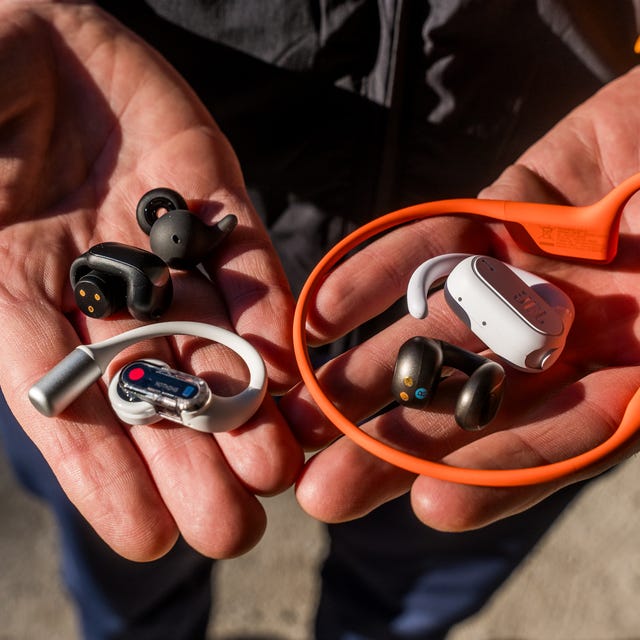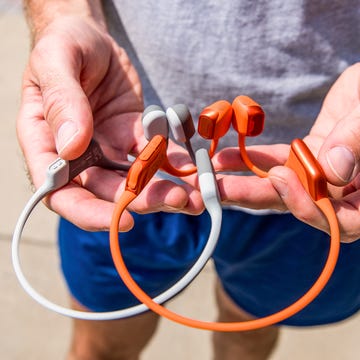The 8 Best Open-Ear Headphones for Running
We logged hundreds of miles to find which deliver the best sound, fit, and durability.

We earn a commission for products purchased through some links in this article. Why Trust Us?
A strong playlist and a pair of wireless headphones are key for me to turn a humdrum jog into a great run. But, when I’m logging miles outside and sharing the road with cars, I prefer to keep my ears open to my surroundings. That’s where “open-ear buds” shine. They’re the newest advancement in personal audio, marrying (mostly) excellent sound quality and ambient awareness so I can still enjoy music while remaining in tune to what’s happening around me.
These are the best open-ear running headphones that I have tested, and reach for when I head out the door.
The Best Open-Ear Headphones
- Best Overall: Bose Ultra Open
- Best Bone Conduction: Shokz OpenRun Pro 2
- Best Design: Nothing Ear (open)
- Best Battery: Shokz OpenFit 2
- Best Ear Hook: JBL SoundGear Sense
More safety gear and running tech we recommend: The Best Reflective Running Gear | The Best Running Lights | The Best Running Headphones
Why Trust Us
The Runner’s World Test Team and staff editors have been testing gear tirelessly for over 50 years. And while we spend a lot of time thinking about shoes, there are very few runs that go by where we don’t also have a set of earbuds playing as we make the rounds on our favorite loops. We’ve seen it all from the classic Sony Sports Walkman to Apple Watches that can stream any track you want, thanks to modern Bluetooth and cellular technologies.
Every set of headphones we test has to stand up to our methods before we review them. We don’t just select the most popular models, for example. We recommend the ones that work best for us during our own runs, because we know that you’ll love them when you buy them yourself. We’ve sweat in them for hundreds of miles, ensured the fit is comfortable at any running speed, and evaluated just how much they helped improve our own daily jogs. In the end, the recommendations below come only from our test editors based on hundreds of miles of use—without any external input, especially from the manufacturers.
How We Tested
Just about the only time I am not listening to something through headphones is when I head out with my Runner’s World colleagues for a lunch run—conversation rules those group runs. But, on the other thousands of miles I log each year, I’m listening to music, audio books, podcasts and more, taking as many notes about the buds on my ears as the shoes on my feet.
Like most runners, I use music to get through the hardest workouts and love to get pumped up. (The Runner’s World test team conducted a test on whether a song’s beat alters how fast you run.) Before I head out the door, I might sync a playlist to a Garmin Forerunner or, even when out on the road, ask Siri for a mid-run surprise via an Apple Watch. For long runs and recovery jogs, I’m probably listening to books or podcasts, to relax and let the miles flow.
Listening to a wide range of audio types lets me evaluate each headphone’s strengths and weaknesses—like whether the bass pumps to today’s biggest hit songs, or if spoken word gets drowned out by a diesel-powered Dodge Ram pickup. I also evaluate the fit and comfort on everything from intervals on a track to 20-mile long runs, where unwanted pressure could spoil an otherwise good training session.
I don’t intentionally try to destroy the gear that I get to test, but sometimes it happens as sweat builds for hours—just like it will when you use the devices. I’ve test these headphones on sweltering August days where salt builds up on charging contacts, as well as on the coldest winter days to see if the battery charge holds up to the weather.
The headphones recommended here aced our tests and are sure to bring you hundreds of miles of entertainment.
Full Reviews
Jeff is Runner-in-Chief for Runner’s World and the director of product testing. He has tested and reviewed running shoes, GPS watches, headphones, apparel, and more for nearly two decades. He regularly tests more than 100 pairs of shoes each year, and once had a 257-day streak running in different models. Jeff can usually be found on the roads, racing anything from the mile to a marathon, but he also enjoys racing up mountains and on snowshoes. When he’s not running, you’ll probably find him hanging from a ladder making repairs and renovations to his house (he’s also director of product testing for Popular Mechanics).

Readers Also Read

The 8 Best Running Headphones in 2025

The 8 Best Running Headphones in 2025

Shokz OpenRun vs OpenRun Pro Headphones

Shokz OpenRun vs OpenRun Pro Headphones













